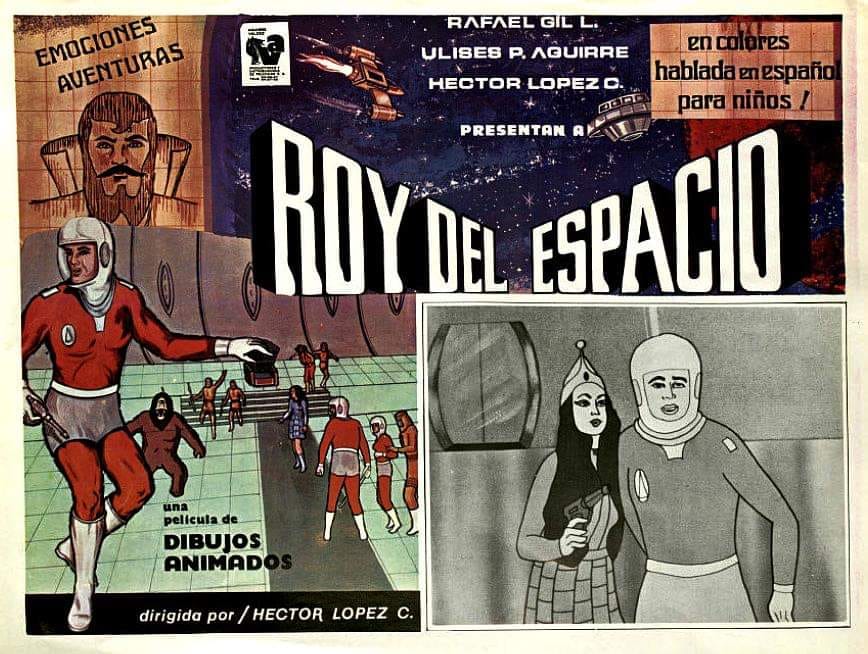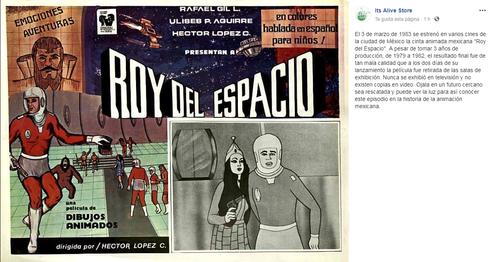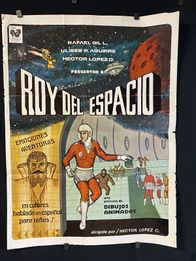Roy del Espacio (lost Mexican animated film; 1983): Difference between revisions
Donrodrigo63 (talk | contribs) No edit summary |
Donrodrigo63 (talk | contribs) No edit summary |
||
| Line 5: | Line 5: | ||
|status=<span style="color:red;">'''Lost'''</span> | |status=<span style="color:red;">'''Lost'''</span> | ||
}} | }} | ||
'''''Roy Del Espacio''''' (aka '''''Roy From Space''''') was a Mexican animated movie directed by Hector Lopez Carmona, Rafael Angel Gil and Ulises P. Aguirre that was | '''''Roy Del Espacio''''' (aka '''''Roy From Space''''') was a Mexican animated movie directed by Hector Lopez Carmona, Rafael Angel Gil and Ulises P. Aguirre that was produced from 1979 to 1982, being released in theaters in Mexico City on March 3rd, 1983.<ref>[https://books.google.com.co/books?id=XLxBcHacjkAC&pg=PA164&lpg=PA164&dq=roy+del+espacio+1983&source=bl&ots=UgX0vBdrea&sig=ACfU3U1506mcNNay_p6TIwfmSLt4aby-Pg&hl=es&sa=X&ved=2ahUKEwjqpOfDtevqAhUEnOAKHVDtCjsQ6AEwFXoECAoQAQ#v=onepage&q&f=false ''Cartelera cinematográfica, 1980-1989''] Retrieved 26 Jul '20</ref> It was the third Mexican animated feature film made. The online information about Carmona and Gil is nonexistent, but Perez Aguirre is the only one who has credits as producer and writer of several movies. Aguirre was involved in sex comedies and low-budget explotation films during the eighties, as IMDB shows<ref>[https://www.imdb.com/name/nm0701829/ ''Ulises Pérez Aguirre. IMDb''] Retrieved 04 Jul '21</ref>. Nonetheless, there is not biographical information that can establish if he is still alive. The scarce plot details available on IMBd go as follow: Alome, emperor of a distant red planet, threatens to destroy Earth. Roy, Dr. Faz and psychologist Elena are sent by Earth leaders in a peace mission to this planet, but they get involved in a series of adventures that include romance, robot fights and space battles. | ||
==Production== | ==Production== | ||
| Line 11: | Line 11: | ||
==Premiere== | ==Premiere== | ||
''Roy del Espacio'' was finally premiered on March 3, 1983 in twelve cinemas from Mexico City. However, the final result was of really poor quality, so much that the movie was pulled from ten of those twelve theaters, only two days after its premiere. The other two remaining | ''Roy del Espacio'' was finally premiered on March 3, 1983 in twelve cinemas from Mexico City. However, the final result was of really poor quality, so much that the movie was pulled from ten of those twelve theaters, only two days after its premiere. The other two remaining ones played the movie for one more week<ref>[https://132.248.9.195/ptd2009/septiembre/0648139/0648139.pdf ''El Zorro Curioso: cortometraje de animación para niños (Dissertation)''] Retrieved 04 Jul '21</ref>. Fernando Ruiz, another renowned | ||
animator, and one of the very few people who actually managed to see the movie, said in this regard: ''"we were five people in the theater. But after a while, I was the only person there, and I was forced to stay because I work as an animator"''<ref>[https://biblio.upmx.mx/tesis/150370.pdf ''Revisión histórica y recopilación de cortometrajes de animación producidos en México (1917-2014) (Dissertation)''] Retrieved 04 Jul '21</ref>. After this short-lived screening time, no other exhibition attempts were heard of. The movie was never broadcasted on TV nor released on home video. It would take another 24 years for another Mexican animated feature film to be released commercially. | |||
==Mentions== | ==Mentions== | ||
While the online information available is still limited to a handful of websites, the movie has been mentioned or reviewed in three books throughout these years. The first mention is made in ''Anuario Cinematográfico 84'' (Cinematographic Yearbook 84), edited by the National Autonomous University of Mexico Film Archive (Filmoteca UNAM) and published in 1984.<ref>[https://books.google.com.co/books?hl=es&id=68kuAAAAYAAJ&dq=anuario+cinematográfico+84+unam&focus=searchwithinvolume&q=roy+del+espacio ''Anuario Cinematográfico 84''] Retrieved 13 Apr '21</ref> Here ''Roy'' only has a synopsis, which, judging by the preview in Google Books, is considerably detailed. The second reference can be found in the book ''El Episodio Perdido: Historia del cine mexicano de animación'' (The Lost Episode: History of Mexican Animated Cinema), written by comic book scholar Juan Manuel Aurrecoechea and published by Cineteca Nacional in 2004.<ref>[https://books.google.com.co/books?hl=es&id=wnkWAQAAIAAJ&dq=El+episodio+perdido%3A+historia+del+cine+mexicano+de+animación&focus=searchwithinvolume&q=roy+del+espacio ''El Episodio Perdido: Historia del cine mexicano de animación''] Retrieved 13 Apr '21</ref> Aurrecoechea quotes third-party accounts that describe the film as "an extravagance, a daring experiment and (…) an unmitigated disaster". The third reference is part of ''El Futuro más Acá: Cine mexicano de Ciencia Ficción'', written by by Itala Schmelz and published by CONACULTA in 2006, in which a brief synopsis is made along with a critical comment.<ref>[https://books.google.com.co/books?id=EuIuAAAAYAAJ&q=El+Futuro+Más+Acá,+Cine+Mexicano+de+Ciencia+Ficción+roy&dq=El+Futuro+Más+Acá,+Cine+Mexicano+de+Ciencia+Ficción+roy&hl=es&sa=X&ved=2ahUKEwiV-qfYt_vvAhW7TDABHfOOD54Q6AEwAHoECAIQA ''El Futuro más Acá: Cine mexicano de Ciencia Ficción''] Retrieved 04 Jul '21</ref> | While the online information available is still limited to a handful of websites, the movie has been mentioned or reviewed in three books throughout these years. The first mention is made in ''Anuario Cinematográfico 84'' (Cinematographic Yearbook 84), edited by the National Autonomous University of Mexico Film Archive (Filmoteca UNAM) and published in 1984.<ref>[https://books.google.com.co/books?hl=es&id=68kuAAAAYAAJ&dq=anuario+cinematográfico+84+unam&focus=searchwithinvolume&q=roy+del+espacio ''Anuario Cinematográfico 84''] Retrieved 13 Apr '21</ref> Here ''Roy'' only has a synopsis, which, judging by the preview in Google Books, is considerably detailed. The second reference can be found in the book ''El Episodio Perdido: Historia del cine mexicano de animación'' (The Lost Episode: History of Mexican Animated Cinema), written by comic book scholar Juan Manuel Aurrecoechea and published by Cineteca Nacional in 2004.<ref>[https://books.google.com.co/books?hl=es&id=wnkWAQAAIAAJ&dq=El+episodio+perdido%3A+historia+del+cine+mexicano+de+animación&focus=searchwithinvolume&q=roy+del+espacio ''El Episodio Perdido: Historia del cine mexicano de animación''] Retrieved 13 Apr '21</ref> Aurrecoechea quotes third-party accounts that describe the film as ''"an extravagance, a daring experiment and (…) an unmitigated disaster"''. The third reference is part of ''El Futuro más Acá: Cine mexicano de Ciencia Ficción'', written by by Itala Schmelz and published by CONACULTA in 2006, in which a brief synopsis is made along with a critical comment.<ref>[https://books.google.com.co/books?id=EuIuAAAAYAAJ&q=El+Futuro+Más+Acá,+Cine+Mexicano+de+Ciencia+Ficción+roy&dq=El+Futuro+Más+Acá,+Cine+Mexicano+de+Ciencia+Ficción+roy&hl=es&sa=X&ved=2ahUKEwiV-qfYt_vvAhW7TDABHfOOD54Q6AEwAHoECAIQA ''El Futuro más Acá: Cine mexicano de Ciencia Ficción''] Retrieved 04 Jul '21</ref> | ||
==Alternative Poster Found== | ==Alternative Poster Found== | ||
Revision as of 16:29, 11 July 2021
Roy Del Espacio (aka Roy From Space) was a Mexican animated movie directed by Hector Lopez Carmona, Rafael Angel Gil and Ulises P. Aguirre that was produced from 1979 to 1982, being released in theaters in Mexico City on March 3rd, 1983.[1] It was the third Mexican animated feature film made. The online information about Carmona and Gil is nonexistent, but Perez Aguirre is the only one who has credits as producer and writer of several movies. Aguirre was involved in sex comedies and low-budget explotation films during the eighties, as IMDB shows[2]. Nonetheless, there is not biographical information that can establish if he is still alive. The scarce plot details available on IMBd go as follow: Alome, emperor of a distant red planet, threatens to destroy Earth. Roy, Dr. Faz and psychologist Elena are sent by Earth leaders in a peace mission to this planet, but they get involved in a series of adventures that include romance, robot fights and space battles.
Production
While most of the details of the production remain unknown, thanks to a Reddit thread on r/mexico[3], where users Modern_harpsichord and Escilas compiled several sources, it is possible to know some details about the production process of the movie. The director, Hector Carmona, has been described as unprofessional and unskilled, since he had plenty of experience as cameraman, but none as an animator[4]. Ignacio "Nacho" Renteria, a veteran animator, and so far, the only known professional artist who participated in the movie, gives a general idea of the carelessness that surrounded the creation of Roy. Renteria said that the paper used for the drawings was tissue paper, instead of bond paper. Additionally, there was not much attention to details, since Renteria tells at times he had problems trying to determine if Roy was holding a gun or another type of weapon, or even if the spaceship that arrived to a place in one scene was the same that departed during the previous one. It is known that the movie was crudely rotoscopied, plagiarizing real-action Flash Gordon movies. [5]
Premiere
Roy del Espacio was finally premiered on March 3, 1983 in twelve cinemas from Mexico City. However, the final result was of really poor quality, so much that the movie was pulled from ten of those twelve theaters, only two days after its premiere. The other two remaining ones played the movie for one more week[6]. Fernando Ruiz, another renowned animator, and one of the very few people who actually managed to see the movie, said in this regard: "we were five people in the theater. But after a while, I was the only person there, and I was forced to stay because I work as an animator"[7]. After this short-lived screening time, no other exhibition attempts were heard of. The movie was never broadcasted on TV nor released on home video. It would take another 24 years for another Mexican animated feature film to be released commercially.
Mentions
While the online information available is still limited to a handful of websites, the movie has been mentioned or reviewed in three books throughout these years. The first mention is made in Anuario Cinematográfico 84 (Cinematographic Yearbook 84), edited by the National Autonomous University of Mexico Film Archive (Filmoteca UNAM) and published in 1984.[8] Here Roy only has a synopsis, which, judging by the preview in Google Books, is considerably detailed. The second reference can be found in the book El Episodio Perdido: Historia del cine mexicano de animación (The Lost Episode: History of Mexican Animated Cinema), written by comic book scholar Juan Manuel Aurrecoechea and published by Cineteca Nacional in 2004.[9] Aurrecoechea quotes third-party accounts that describe the film as "an extravagance, a daring experiment and (…) an unmitigated disaster". The third reference is part of El Futuro más Acá: Cine mexicano de Ciencia Ficción, written by by Itala Schmelz and published by CONACULTA in 2006, in which a brief synopsis is made along with a critical comment.[10]
Alternative Poster Found
In December 2020, an alternative poster (sold in June 2021) from the movie was listed on Ebay. This poster does not have any movie still as the other one shown on this page. Regarding the origin of the item, the seller claims it comes from a "regional film archive in Mexico that had serviced 20 theaters for 50 years from the 1930s to the 1980s". It also shows on the left top corner the logo of the distribution company, Aguirre Valdez Productores y Distribuidores de Películas S.A., along with the contact information, but there is no certainty if the company is still operating as there is no information online about it.
This new poster, along with the one containing both original art and a black and white still, are currently the only visual information of any kind available from the movie.
Gallery
References
- ↑ Cartelera cinematográfica, 1980-1989 Retrieved 26 Jul '20
- ↑ Ulises Pérez Aguirre. IMDb Retrieved 04 Jul '21
- ↑ Roy del Espacio (1983) - película animada mexicana perdida. Reddit Retrieved 04 Jul '21
- ↑ El Zorro Curioso: cortometraje de animación para niños (Dissertation) Retrieved 04 Jul '21
- ↑ Iniciadores de la animación en México: Nacho Rentería. Animación Mexicana (Blog) Retrieved 04 Jul '21
- ↑ El Zorro Curioso: cortometraje de animación para niños (Dissertation) Retrieved 04 Jul '21
- ↑ Revisión histórica y recopilación de cortometrajes de animación producidos en México (1917-2014) (Dissertation) Retrieved 04 Jul '21
- ↑ Anuario Cinematográfico 84 Retrieved 13 Apr '21
- ↑ El Episodio Perdido: Historia del cine mexicano de animación Retrieved 13 Apr '21
- ↑ El Futuro más Acá: Cine mexicano de Ciencia Ficción Retrieved 04 Jul '21


